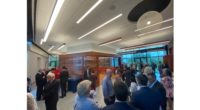Following years of fundraising, design and construction to implement the first phase of a new master plan, the sanctuary renovation of a beloved synagogue in Scarsdale, New York, is finally complete, welcoming worshippers back to regular services in a completely reimagined sunlit sanctuary.
Designed by Landau|Zinder Architecture, a boutique firm providing design and architectural services to the Jewish community nationally, the redesign of Scarsdale Synagogue Temples Tremont and Emanu-el has transformed the sanctuary from something almost barn-like to a more modern and highly flexible space, supporting the synagogue leadership’s desire to support a wide range of service types. At the same time, the architects have completely refreshed the building exterior to harmonize aesthetically with the synagogue’s adjacent school building.
“It has been our pleasure and honor to work with the Scarsdale Synagogue community for many years, starting with consultation on a new master plan and culminating in the completion of recent construction,” said Joshua Zinder, AIA, LEED AP, the design architect and partner in Landau|Zinder Architecture with Michael Landau, AIA. “We believe the updated facility, which is flexible, universally accessible, acoustically balanced and energy-efficient, will support the goals of the leadership and community for the foreseeable future.”
In order to realize master plan goals for use of the sanctuary, Landau|Zinder recommended the bold act of demolishing and rebuilding the entire east-, west- and south-facing walls while leaving the roof structure and supports in place. The new broadly curved wall at the front of the sanctuary features twelve vertical windows to fill the sanctuary with natural daylight – the number symbolically representing the Twelve Tribes of Israel. The architects continued the exterior transformation by removing an outdated façade and replacing it with zinc panels at the roof line and fiber cement panels that replicate the appearance of limestone on the walls, creating a more modern look that harmonizes with the adjacent educational building’s architecture.

Photo courtesy of Landau Zinder
Spiritual Symbolism
Inside, the architects leveled the stepped concrete floor, replacing tile with comforting carpet and introducing moveable seats for flexible reconfiguration. The leveled floor is just one design element addressing accessibility: for example, a ramp connects the sanctuary floor to the bimah, the platform from which services are led.
The twelve windows are just the beginning of the symbolism woven throughout the design. The new south wall is also clad in Jerusalem stone, a choice that evokes a timeless feel, while the adjacent walls are covered with salvaged cedarwood that originally adorned the sanctuary interior, refinished and reinstalled as an homage to the synagogue’s history, but in a more appealing and contemporary patterning. Above, the architects introduced a coffered “pop-up” ceiling defined at the corners by four existing structural columns – a gesture representing a chuppah, the ceremonial canopy symbolizing home in Jewish wedding traditions, sheltering all congregants.
Landau|Zinder also designed the new Ark – the fixed ornate cabinet containing and enshrining the Torah scrolls – with layers of symbolism:
- FSC-certified sustainable redgum wood used for its resemblance to olive wood.
- The Ark’s abstract form resembles a burning bush.
- The design incorporates visual representations of the three uses of the word “ark” from Torah: Noah’s ark, Moses’ rush basket, and the Ark of the Covenant.
The aesthetic choices and symbolic gestures “complement the musical, liturgical and pedagogical goal of helping us to cultivate an inner relationship with the Divine,” said Scarsdale Synagogue leader Rabbi Jeffrey Brown.

Photo courtesy of Landau Zinder
Beyond symbolism, the redesign includes important upgrades intended to improve the worship experience and extend the reach of the synagogue’s offerings. The sanctuary interior features acoustic panels and new technology, such as large flat-screen monitors, to benefit in-person congregants and the audiovisual infrastructure necessary to carry services over the internet to support virtual attendance.
According to Zinder, the first two phases of the four-phase master plan are now complete: the first represented by the completion of the new sanctuary and outer wall, and the second by the addition of an entry vestibule to provide a layer of physical security. In addition, Landau Zinder provided support for the application of grants from the Department of Homeland Security, helping to subsidize security enhancements.
Work on future phases is ongoing and will ultimately result in new gathering areas and social spaces within the synagogue building, as well as outdoor venues.









